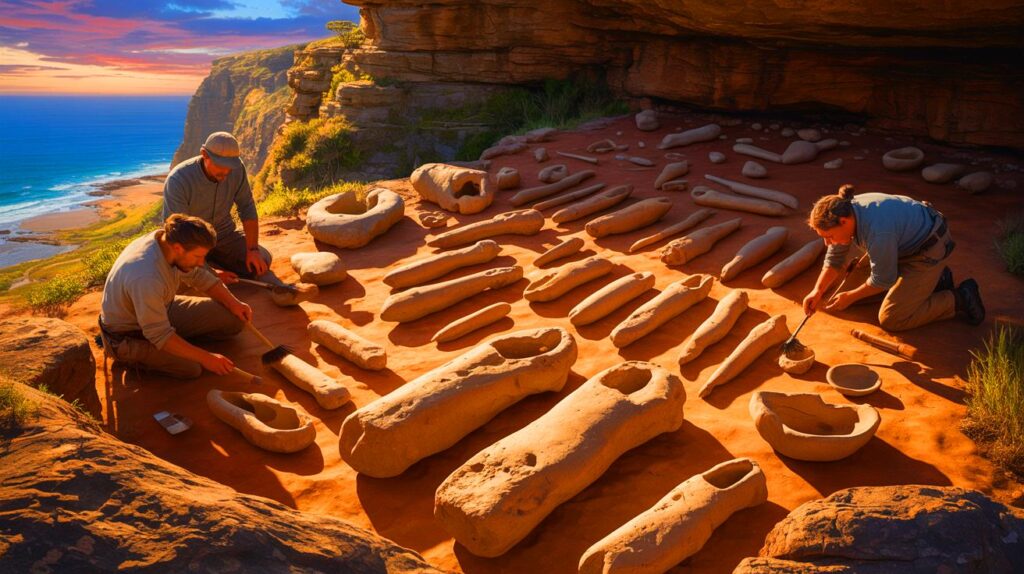| IN BRIEF |
|
The recent discoveries in South Africa shed fascinating light on the ingenuity of prehistoric cultures. These stone tools, uncovered at a previously inaccessible site, not only reveal our ancestors’ survival but also their ability to organize complex social networks. These artifacts testify to a collective memory and an advanced technical culture, long before the first pages of our written history. The meticulous excavation of the KEH-1 cave has unveiled an archaeological richness that redefines our understanding of prehistory.
The KEH-1 Cave: A Unique Archaeological Site
Located 75 meters above current sea level, the KEH-1 cave overlooks the South African coast. During the last ice age, it commanded a vast plain, offering a breathtaking view of a now-lost landscape. It is in this exceptional setting that Sara Watson’s team from the Field Museum in Chicago began their research. The challenging access to the cave, requiring harnesses and makeshift ladders, was a significant obstacle. However, this isolation also protected the remains from the elements and erosion, preserving nearly intact sedimentary layers for millennia.
Thanks to the team’s efforts, an exceptional lithic assemblage was discovered, consisting of diverse stone tools. These artifacts, aligned after extraction, illustrate a variety of shapes and functions, showcasing the craftsmanship of the region’s ancient inhabitants. The site’s stability provided a unique window into a distant past, allowing the study of a culture capable of adapting to ever-changing environments.
Prehistoric Tools: Witnesses of a Sophisticated Culture
The artifacts found at KEH-1 are linked to the Robberg technocomplex, a well-documented culture in Southern Africa. This cultural complex, active between 26,000 and 12,000 years ago, is characterized by the production of “bladelets”, small blades crafted with great precision. These blades, analyzed by Sara Watson and her team, reveal a standardization of techniques and impressive technical mastery.
Likely intended as points for composite weapons, these blades were essential for long-distance hunting in open environments. Their sophisticated manufacture reflects a remarkable technical and environmental adaptability, highlighting the ingenuity of these prehistoric peoples. Beyond their immediate utility, these tools embody a deep understanding of materials and techniques, as well as a desire to refine their methods.
A Large-Scale Transmission of Know-How
The stone tools from KEH-1 reveal unexpected social dynamics. Compared to those from other South African sites, the artifacts show striking similarities, suggesting a diffusion of techniques over vast distances. The stone-knapping methods used at KEH-1 have been observed as far away as Namibia and Lesotho.
This technical coherence hints at a conscious transmission of know-how, facilitated by cultural exchanges between distant groups. While respecting the broad guidelines of the Robberg technocomplex, the tools from KEH-1 exhibit specific characteristics, such as slightly larger sizes and less frequent use of bipolar percussion. These differences suggest a temporary use of the site, likely as a hunting camp. This transitory nature reinforces the idea of a network for the circulation of ideas, where each site contributed to technical diversity while sharing a common foundation.
A Cultural and Technical Legacy
The discovered artifacts are not just utilitarian objects. They represent the memory of a transmission of gestures and knowledge across generations. By tracing their history, archaeologists illuminate the capacity of humanity to cooperate and exchange across long distances. Sara Watson emphasizes that these Paleolithic populations shared our ability to adapt and innovate, illustrating a complex communication network long before writing.
These discoveries prompt us to rethink our cultural and technical heritage. What do these tools say about the social organization of these peoples? How did they influence subsequent cultures? These questions remain open and fuel our fascination for a past that continues to reveal its secrets.







